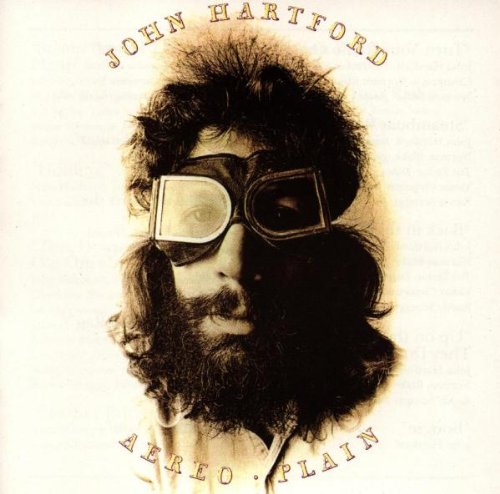
With its release in September 1971, John Hartford’s masterwork, Aereo-Plain, heralded the coming of a new bluegrass era where a musical genre that had long-defined itself by reference to—and reverence of—the traditional opened its ranks to a new generation of players and songwriters that would revitalize it in a new form and bring newgrass to the world. Though it has not historically been read as a concept album, the potent recurring themes and unique, deliberate, and groundbreaking musical style suggest that a broader concept was Hartford’s intent. Given the revolution of the genre heralded by its release, it’s quite appropriate that the album broke new ground by bringing the concept album from its pop and rock breeding ground to the world of bluegrass.
The earliest concept albums are credited to Frank Sinatra in the 1940s and 50s. But by the late 1960s, rock bands like The Beatles ( Sgt. Pepper’s Lonely Hearts Club Band), The Beach Boys ( Pet Sounds), The Who ( Tommy), and Frank Zappa and the Mothers of Invention ( Freak Out!) had become the vanguard of the concept album. There is no single, clear definition of or criteria for what constitutes a concept album, and composers and bands have approached them in different ways. On one end of the spectrum, records like Tommy and Pink Floyd’s The Wall were fully realized rock operas ( Tommy would go onto be staged on Broadway and The Wall became a feature film). Other examples were less obviously conceptual. Pink Floyd’s Dark Side of the Moon is tied together by thematic and metaphorical content, in addition to its cohesive sound. Sgt. Pepper’s is a less-structurally and thematically coherent attempt at creating an alter-ego for The Beatles. Brian Wilson has described Pet Sounds as a “production concept album,” where thematically and lyrically unlinked songs are tied together instead by Wilson’s consistent application to them of Wilson’s interpretation of Phil Spector’s “Wall of Sound” production style.
Willie Nelson released three concept albums in the early 1970s that are widely considered to have brought the concept album to the country genre. 1971’s Yesterday’s Wine tells the story of the Imperfect Man. 1974’s Phases and Stages is an album-length rumination on divorce from both sides of a failed marriage. 1975’s Red Headed Stranger is a sprawling Western story of the title character’s loves, murders and redemption. Aereo-Plain, which introduced the concept form to bluegrass, was released just months after the first of these Nelson albums.
Aereo-Plain is conceptual in its thematic and lyrical content as well as its musical sounds and style. Thematically, Aereo-Plain is a conceptual record that meditates on the clash of tradition and modernity: the old and the new. “Steam Powered Aereo-Plane,” the ethereal, banjo-driven, dream-lyric about Hartford’s desire to pilot the titular vehicle, hints perhaps most powerfully and succinctly at the album’s thematic content, imagining an invention that melds transportation’s past and its future. It is no accident that this song, the album’s conceptual anchor, is also its quasi-title track.
The record’s non-lyrical content mirrors this statement about the collision of the traditional and the modern through a deliberate and jarring juxtaposition of musical styles, in which a band comprised of Nashville’s finest traditional bluegrass musicians breaks from formal traditions to play everything from Hartfordian novelties (“Boogie”), to country-ish love songs (“First Girl I Ever Loved”), to numbers that approach harmonic movement and rhythmic feel of rock and roll (“Up on the Hill Where They Do The Boogie,” “Back in the Goodle Days”), to a mock radio commercial (Station Break”), a traditional fiddle song (“Leather Britches”). Perhaps uniquely, then, the message and the medium collapse into one another in Hartford’s conceptual masterpiece.
There is perhaps no artist better suited to carry this particular message than Hartford, the Old Time Riverman who, sporting aviator goggles, long-haired, and bushy-bearded, with banjo-in-hand, simultaneously embodied the exploration of music’s outer bounds while studiously understanding and dutifully paying tribute to its traditions.
David Bromberg, who produced Aereo-Plain, has commented on the direction Hartford was looking to take with the record, suggesting that a consistent musical direction was indeed what Hartford had in mind:
Someone once told me that John had told them he asked me to produce it because he wanted a New York City viewpoint. I think that is correct. In New York, we’d sit around and smoke pot and play ‘Sally Goodin’ for an hour and a half. That approach kind of became, after a while, Newgrass. John wanted some of the wild playing that we did in New York. After about 30 choruses of ‘Sally Goodin’, it begins to get strange. And that’s what he liked. I think if he had gotten a Nashville producer, he wouldn’t have gotten that. I think I was chosen because I understood that direction.
Bromberg also noted some specific instructions about how the album was to be engineered and produced, suggesting a production concept (not entirely unlike Wilson’s) was also in Hartford’s mind:
He asked me to produce the record in a way I’ve never heard of any other record being produced. He didn’t want anyone to hear a single playback, not[] one, until the record was mixed and sequenced. I basically produced it in a vacuum. I had nobody to consult with.
Additionally, Aereo-Plain utilizes one of the most common tools in the language of concept albums: the reprise. “Turn Your Radio On” opens and closes the album, a technique often used to remind the listener to re-consider the arc of the record from the first iteration of a song through its reprise. Tommy hints at themes in its “Overture” and “Underture” that reappear throughout; Red Headed Stranger repeatedly returns to the “Time of the Preacher”; Dark Side of the Moon opens and closes with the same sound of a heartbeat; and The Wall brings us several versions of “Another Brick in the Wall,” and reprises that song’s melodic content again in “Hey You.”


No Comments comments associated with this post